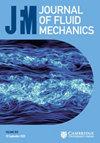关于三维和湍流圆筒形气流中不存在次级涡街的问题
IF 3.9
2区 工程技术
Q1 MECHANICS
引用次数: 0
摘要
当雷诺数超过几百时,崖体尾流通常会变成三维(3-D)湍流。除了机体后方的跨向涡流交替脱落以及涡流随下游距离逐渐衰减和湮灭之外,在相对较远的尾流中是否会形成次级涡街一直是文献中争论不休的问题。本研究对这一争论进行了探讨。具体而言,本研究通过直接数值模拟和瞬态增长分析,研究了不同崖体的二维和三维尾流,包括不同横截面长径比的圆柱体、方形圆柱体、菱形圆柱体和矩形圆柱体。我们发现,大多数三维和湍流漩涡都不存在二次涡街。根本原因是三维湍流不稳定模式和流向环流/涡度削弱了跨向涡街。被削弱的跨向涡流会导致中间唤醒区的平均剪切力减小,进而导致扰动能量增长小得多,低于次级涡街出现的阈值。这一发现表明,崖体相对较远的尾流中的三维和湍流特性以及动量、质量和热量传输不会受到次级涡街引起的额外各向异性或不均匀性的影响。本文章由计算机程序翻译,如有差异,请以英文原文为准。
On the absence of a secondary vortex street in three-dimensional and turbulent cylinder wakes
Bluff-body wakes generally become three-dimensional (3-D) and then turbulent when the Reynolds number exceeds a few hundred. Other than an alternate shedding of the spanwise vortices behind the body and a gradual decay and annihilation of the vortices with distance downstream, whether a secondary vortex street would develop in the relatively far wake has been a long-standing argument in the literature. This argument is addressed in the present study. Specifically, direct numerical simulations and transient growth analysis are performed to examine the two-dimensional and 3-D wakes of different bluff bodies, including circular cylinder, square cylinder, diamond cylinder and rectangular cylinders with different cross-sectional aspect ratios. We found that a secondary vortex street is absent for most 3-D and turbulent wakes. The root cause is the weakening of spanwise vortices by 3-D wake instability modes and streamwise circulation/vorticity. The weakened spanwise vortices induce reduced mean shear in the intermediate wake, which then induces much smaller perturbation energy growth that is below the threshold for the emergence of a secondary vortex street. This finding suggests that the 3-D and turbulence characteristics, and the momentum, mass and heat transport in the relatively far wake of bluff bodies, would not be influenced by extra anisotropy or inhomogeneity caused by a secondary vortex street.
求助全文
通过发布文献求助,成功后即可免费获取论文全文。
去求助
来源期刊
CiteScore
6.50
自引率
27.00%
发文量
945
审稿时长
5.1 months
期刊介绍:
Journal of Fluid Mechanics is the leading international journal in the field and is essential reading for all those concerned with developments in fluid mechanics. It publishes authoritative articles covering theoretical, computational and experimental investigations of all aspects of the mechanics of fluids. Each issue contains papers on both the fundamental aspects of fluid mechanics, and their applications to other fields such as aeronautics, astrophysics, biology, chemical and mechanical engineering, hydraulics, meteorology, oceanography, geology, acoustics and combustion.

 求助内容:
求助内容: 应助结果提醒方式:
应助结果提醒方式:


